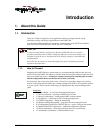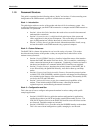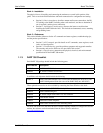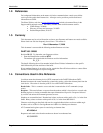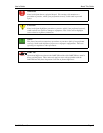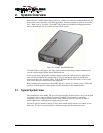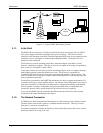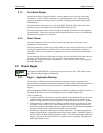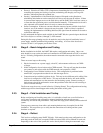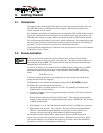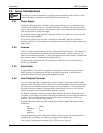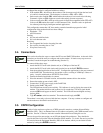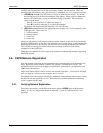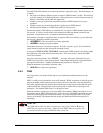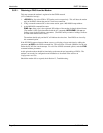
User’s Guide System Overview
2110212 Rev 1.0 Page 9
2.1.3. The Central Monitor
The units in the field are typically linked to a central computer used to monitor, and possibly
control them. In most cases the connection uses a standard Internet service. The monitoring
system can be connected to the network by any means, including another DART 300 using the
CDPD network.
Since this document takes the point of view of the DART 300 in the field location, the central
monitoring system is considered remote while the DART modem is local.
This remote host must be able to receive the data from multiple local field units and distinguish
one from another. This may be done by polling the individual stations in turn, or by maintaining
different IP ports (sockets) for each device.
2.1.4. Client / Server
In any data exchange over IP, there must be a client (originating the session) and a server
(responding to client requests).
If the central monitoring system uses a polling method to collect data, the monitor acts as a client,
soliciting data from the units in the field (servers). Most telemetry installations use polling to
collect data. In this case, the modem is configured as a server to auto-answer the calls from the
central host.
In cases where the field units initiate the call to report an event or periodic block of data, they are
the clients, calling the central server. The central server may maintain many sessions
simultaneously, accepting data and issuing responses. This is more rare, but is still supported by
the DART 300 modem.
2.2. Project Stages
To integrate the DART 300 into a system requires several stages or steps. This outline covers a
typical case but may not apply to all situations.
2.2.1. Stage 1 – Application Planning
The first task is to define the system requirements, and how the various components of the
network should be configured to meet those requirements. Many of these choices have impacts on
other choices such that the whole system needs to be considered and balanced to maintain
integrity.
After reading about the DART 300 in this guide, you should be equipped to make these decisions.
The nature of the local host device may dictate the answers to many of these issues.
Issues to consider are:
• Local host capability. Dumb devices can only transmit. Semi-intelligent devices can receive
commands using a proprietary protocol but cannot issue or manage AT commands to the
modem. Intelligent devices can be programmed to manage the modem using AT commands.
• IP Stack Location. If the host device is dumb, the modem will have to provide the IP stack
and packet service (UDP or TCP). Semi-intelligent devices may or may not include an IP
stack as part of their communication protocol. If the local host is intelligent and implements a
stack, then a SLIP or PPP connection to the DART may be preferred.
• Client/Server. Determine which end will originate connections. The answering station will
require a fixed IP address so that callers know where to route packets. The DART 300 has a
fixed IP address (its Network Entity Identifier or NEI). The central monitoring station may or
may not. If not, then the monitor will have to originate calls to the modem. That makes the
DART 300 modem a server.



